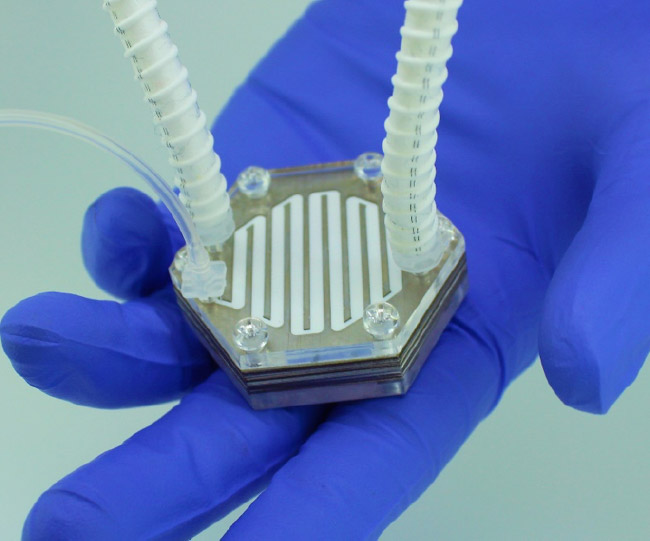
A prototype of the artificial kidney used for animal tests. The size of the artificial kidney for humans will measure only a few centimeters in width, length, and height. © Miki laboratory, Department of Mechanical Engineering, Keio University
Bodies generate a lot of waste. In healthy people the kidneys filter out excess electrolytes like sodium and potassium as well as urea so that it can be expelled in the urine; however, when the kidneys fail to function, alternative ways of flushing waste products from the blood stream are needed. For severe kidney disease, this can involve the patient going to the hospital three times a week to be strapped to a dialysis machine for four hours at a time. Researchers at Keio University and Tokyo Medical University have now reported a key step towards miniaturizing dialysis technology in order to provide implantable alternatives that would free kidney disease patients from the need to spend a significant portion of their lives wired to bulky hospital equipment.
Although milder kidney conditions may be managed by controlling diet and exercise, for those with end-stage kidney disease, health care providers commonly resort to dialysis machines to clear excess waste from the blood. Traditional dialysis uses a dialysate ― a fluid that runs alongside the blood separated by a membrane, through which small waste molecules can easily diffuse, thus leaving the blood stream. The basic principle of running large quantities of dialysate through the machine makes it very difficult to miniaturize, so Norihisa Miki from Keio University and his collaborators therefore sought a simpler approach.
Their device effectively filters the blood directly, a process called hemofiltration (as opposed to hemodialysis). "By not using dialysate, our device can be simplified because the pumps and storage tanks for the dialysis fluid are not necessary," they explain in their report.
Key to the success of the filter device is the water permeability and robustness of the membrane, which must allow the right substances to pass through while withstanding the necessary pressure to push liquids through the filter. The researchers had previously studied whether nanoporous polyethersulfone (PES) could be used as a porous membrane material, but they were unable to achieve the necessary water permeability and robustness to pressure. In their latest work, they experimented with the concentrations of the PES, the additives, and the solvents in the casting solution with the aim of tailoring the membranes properties.
They found that when the PES concentration was too low, the pores were too small, and that when it was too high, the level of thickness of the nanoporous skin layer in the membrane was too high. The highest membrane filtration coefficient, which exceeds the medically recommended target, was achieved with a casting solution of 17.5%.
The researchers pursued further experiments in vitro and in vivo with rats, which confirmed the effectiveness of the filter for removing waste from the blood. They were also able to demonstrate that the filter could be scaled up by using additional layers.

Image of the ex vivo test. © Miki laboratory, Department of Mechanical Engineering, Keio University
In their report they conclude, "Though longer-term experiments are necessary, the experiments successfully verified the potential of the proposed devices as implantable micro dialysis systems."
Published online 27 February 2020
About the researcher

Norihisa Miki ― Professor
Department of Mechanical Engineering, Faculty of Science and TechnologyNorihisa Miki received his Ph.D. in mechano-informatics from the University of Tokyo in 2001, for which he developed what was the world's smallest helicopter at the time using MEMS technology. He then worked at MIT on a microengine project as a postdoc (2001-2003), continuing on as a research engineer (2003-2004). Miki joined the Department of Mechanical Engineering at Keio University in 2004 as an assistant professor and became a full professor in 2017. His research interests began with the development of MEMS-based biomedical and human interface devices, and now, he is also exploring the fields of medical engineering, neuroscience, and media arts using innovative devices. He was a JST PRESTO researcher (Information Environment and Humans) from 2010 to 2016, and has been a member of the Kanagawa Institute of Industrial Science and Technology since 2010. He is a member of IEEE and the JSME Micro-Nano Science and Technology Division, and was a general chair of the 8th and 9th Symposiums on Micro-Nano Science and Technology in 2017 and 2018, which were sponsored by JSME. He co-founded the healthcare startup LTaste Inc. in 2017.
He has served as the president of the Keio University Athletic Association Keio Skating Association since 2018, and enjoys Cuban music and dance, as well as watching and playing sports, fishing, movies, and the arts.
Links
Reference
- N. To, I. Sanada, H. Ito, G. S. Prihandana, S. Morita, Y. Kanno and N. Miki. Water-permeable dialysis membranes for multi-layered micro dialysis system, Frontiers in Bioengineering and Biotechnology, 2015: 3, 70. | article